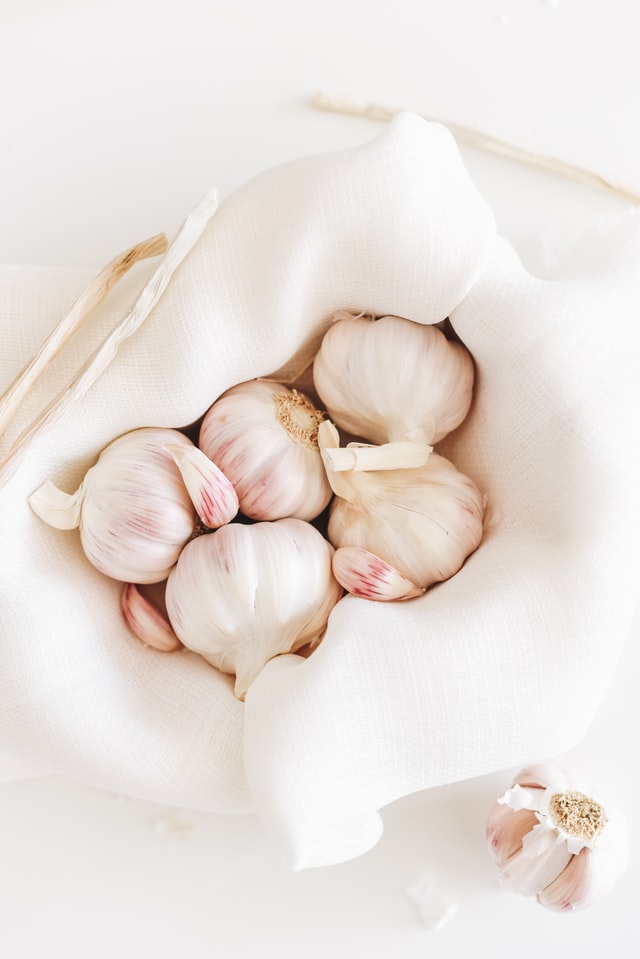


By now, when we think of anti-inflammatory spices, turmeric takes center stage. And for good reason, turmeric’s active compound, curcumin has been vastly studied for its disease-fighting potential and preventive health benefits. However, did you know there’s an entire gamut of powerhouse herbs and spices? While turmeric should always be a staple in your kitchen, these seven other candidates below host their own myriad benefits. Let’s get into it.
1. Black Pepper
Black pepper (Piper nigrum L.) is known to be one of the kings of spices; due to its popularity worldwide. Historically, individuals would use black pepper to treat certain health conditions such as diarrhea, gastric ailments, and asthma. The main active compound, piperine, is what helps play a role in reducing inflammation in the body. In this study, it was shown that in animals with arthritis, piperine helped reduce joint swelling and inflammation markers. When using black pepper for cooking, be sure to use freshly cracked black pepper. When cooking with turmeric, always include a pinch of fresh black pepper, as it enhances the absorption of curcumin significantly.
2. Cardamon
Cardamon (Elettaria cardamomum) is a spice that’s native to Southeast Asia. It has a subtly sweet, yet zingy flavor. Commonly seen in many curries, soups, and Scandinavian pastries. Among its many benefits, cardamom is known for lowering blood pressure, helping treat cavities and bad breath, and may even aid in cancer treatment.
3. Cayenne
While cayenne’s reputation is solely about bringing the heat, this spice has a lot more to contribute than just that. Cayenne (Capsicum frutescens) is an anti-inflammatory powerhouse. It can help aid in digestion, improve circulation, and excessive blood clotting. If you can’t handle spice, paprika boasts some of the same benefits as it comes from dried chili peppers. Other cayenne benefits include plenty of necessary vitamins, like potassium and magnesium, and are a suitable source of phytonutrients. Use it to spice up chili’s, soups, or your favorite popcorn recipe.
4. Garlic
Allium sativum, also known as garlic, is one of the most widespread aromatics used in every cuisine around the world. When eaten raw, it has a sharp yet robust flavor to match its zesty benefits. Most of these benefits come from its sulfur compounds, such as allicin, diallyl disulfide, and S-Allylcysteine, which have anti-inflammatory properties. Other studies have shown that garlic may help increase antioxidants in the body, such as glutathione (GSH) and superoxide dismutase (SOD) while regulating inflammation-promoting markers.
5. Ginger
Outside of ginger’s culinary uses, cultures have used it for centuries in traditional medicine to heal numerous conditions. Ginger (Zingiber officinale) is known for helping with colds, migraines, nausea, arthritis, and high blood pressure. Ginger contains over 100 compounds like gingerol, shogaol, zingiberene, and zingerone, to name a few. These compounds are likely to be responsible for their extensive properties. If you’re looking to start using ginger, try making stir-fry’s or adding it to salad dressing. It also makes for an excellent juicing ingredient.
6. Rosemary
A fragrant herb native to the Mediterranean, Rosemary (Rosmarinus officinalis), may help reduce inflammation. According to research, rosemary is thought to have a high content of polyphenols, particularly rosmarinic acid and carnosic acid. And as we know, foods that are rich in polyphenols have a sizable anti-inflammatory effect. Try using rosemary when pan-searing meats or plopping a few springs onto vegetables before they roast.
7. Sumac
Sumac is a bright, tangy spice with a citrus-like flavor that packs a punch. This spice has a long history in Mediterranean and Middle Eastern cultures. If you’re unfamiliar, sumac (Rhus coriaria) is a flowering shrub that belongs to a family of plants known as Anacardiaceae.
Sumac is rich in antioxidants and contains a variety of nutrients that play a role in lowering inflammation, blood sugar, and muscle pain. Try adding pinches of sumac to fresh watermelon, salads, and avocados.
Related Stories:
6 Herbal Antioxidants That Are Often Overlooked
Surprising Superfoods
今では、抗炎症スパイスといえば、ターメリックが主役になっています。 そして、正当な理由で、ターメリックの活性化合物であるクルクミンは、病気と戦う可能性と予防的な健康上の利点について広く研究されてきました。 しかし、他にも強力なハーブやスパイスがあることをご存知ですか? ターメリックは常にあなたの台所の定番であるべきですが、以下の7つの候補も無数の利益をもたらします。 さあ、始めましょう。
1. ブラックペッパー
黒コショウ(Piper nigrum L.)は、スパイスの王様の1つとして知られています。 世界中で人気があるため。 歴史的に、下痢、胃の病気、喘息などの特定の健康状態を治療するために黒コショウを使用していました。 主な活性化合物であるピペリンは、体内の炎症を軽減する役割を果たすのに役立ちます。 この研究では、関節炎の動物では、ピペリンが関節の腫れや炎症マーカーの軽減に役立つことが示されました。 黒胡椒を使って料理するときは、必ずひびの入った黒胡椒を使ってください。ウコンで調理するときは、クルクミンの吸収を大幅に高めるので、常に新鮮な黒コショウのピンチを含めてください。
2. カルダモン
カルダモン(Elettaria cardamomum)は、東南アジア原産のスパイスです。 ほのかに甘く、しかもピリッとした味わいです。 多くのカレー、スープ、スカンジナビアのペストリーでよく見られます。 その多くの利点の中で、カルダモンは血圧を下げることで知られており、虫歯や口臭の治療に役立ちます、さらには癌治療に役立つ可能性があります。
3. カイエン
カイエンの評判は熱をもたらすことだけですが、このスパイスはそれだけではなく、貢献することがたくさんあります。 カイエン(Capsicum frutescens)は、抗炎症作用のあるものです。 消化を助け、循環を改善し、過度の血液凝固を助けることができます。スパイスを扱えない場合、パプリカは乾燥唐辛子と同じ利点がいくつかあります。 他のカイエンの利点には、カリウムやマグネシウムなどの必要なビタミンがたくさん含まれており、植物栄養素の適切な供給源です。 唐辛子、スープ、またはお気に入りのポップコーンレシピに使用しています。
4. ガーリック
ニンニクとしても知られているAlliumsativumは、世界中のすべての料理で使用されている最も普及している芳香族の1つです。 生で食べると、シャープでありながらしっかりとした味わいで、ピリッとした味わいが様々な料理にマッチします。 これらの利点のほとんどは、アリシン、ジアリルジスルフィドなどの硫黄化合物からもたらされます。また、S-アリルシステイン、これらは抗炎症特性を持っています。 他の研究では、ニンニクがグルタチオン(GSH)やスーパーオキシドなどの体内の抗酸化物質を増やすのに役立つ可能性があることが示されています。またジスムターゼ(SOD)炎症促進マーカーを調節します。
5. 生姜
生姜の料理の用途以外に、文化は何世紀にもわたって伝統医学で生姜を使用して多くの状態を癒してきました。 生姜(Zingiber officinale)は、風邪、片頭痛、 吐き気、関節炎、および高血圧など。 ジンジャーには、ジンゲロール、ショウガオール、ジンギベレン、ジンゲロンなど、100を超える化合物が含まれています。 これらの化合物は、それらの広範な特性に関与している可能性があります。 生姜を使い始めたい場合は、炒め物を作るか、サラダドレッシングに加えてみてください。 また、優れたジュース成分にもなります。
6. ローズマリー
地中海原産の香りのよいハーブ、ローズマリー(Rosmarinus officinalis)は、炎症を抑えるのに役立つ可能性があります。 研究によると、ローズマリーはポリフェノール、特にロスマリン酸とカルノシン酸を多く含んでいると考えられています。 そして私たちが知っているように、ポリフェノールが豊富な食品にはかなりの抗炎症効果があります。 肉をフライパンで焼くときや、野菜をローストする前にローズマリーを使用してみてください。
7. スマック
スマックは、柑橘系の風味がパンチの効いた、明るくピリッとしたスパイスです。 このスパイスは、地中海と中東の文化で長い歴史があります。 ご存じない方のために説明すると、スマック(Rhus coriaria)は、ウルシ科ヌルデ属として知られる植物に属する顕花低木です。
ウルシは抗酸化物質が豊富で、炎症、血糖値、筋肉痛を低下させる役割を果たすさまざまな栄養素が含まれています。 新鮮なスイカ、サラダ、アボカドにスマック1つまみを追加してみてください。
関連記事:
6 Herbal Antioxidants That Are Often Overlooked
Surprising Superfoods